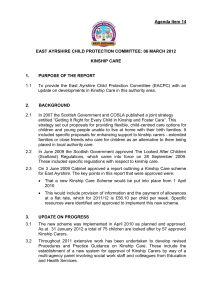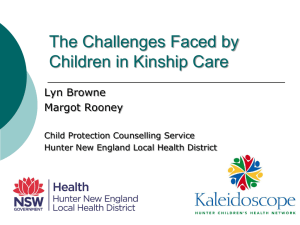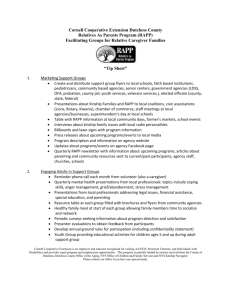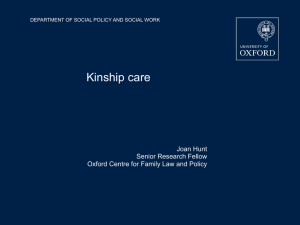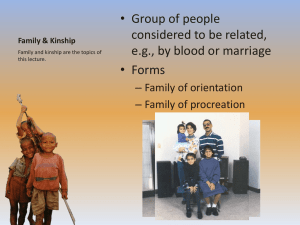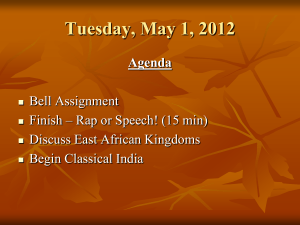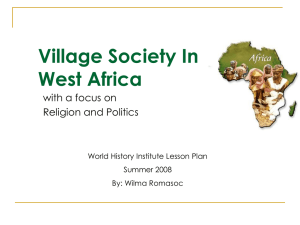Iara Cury Week#5, Elizabeth Ewart 16/02/2011 Kinship and Idioms
advertisement
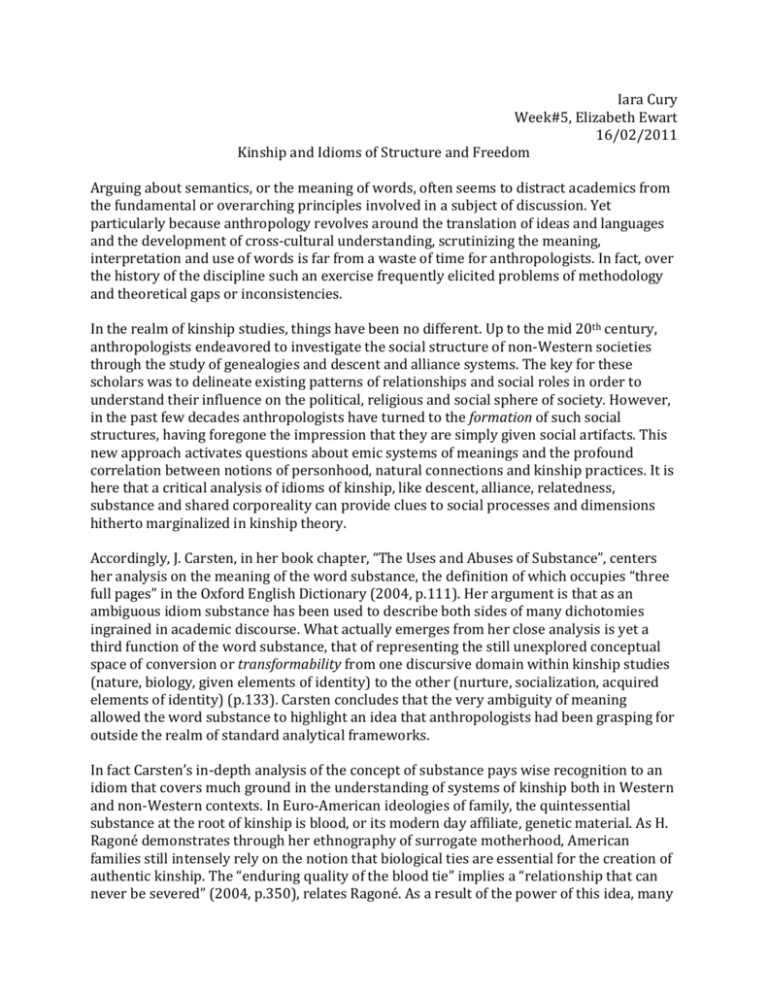
Iara Cury Week#5, Elizabeth Ewart 16/02/2011 Kinship and Idioms of Structure and Freedom Arguing about semantics, or the meaning of words, often seems to distract academics from the fundamental or overarching principles involved in a subject of discussion. Yet particularly because anthropology revolves around the translation of ideas and languages and the development of cross-cultural understanding, scrutinizing the meaning, interpretation and use of words is far from a waste of time for anthropologists. In fact, over the history of the discipline such an exercise frequently elicited problems of methodology and theoretical gaps or inconsistencies. In the realm of kinship studies, things have been no different. Up to the mid 20th century, anthropologists endeavored to investigate the social structure of non-Western societies through the study of genealogies and descent and alliance systems. The key for these scholars was to delineate existing patterns of relationships and social roles in order to understand their influence on the political, religious and social sphere of society. However, in the past few decades anthropologists have turned to the formation of such social structures, having foregone the impression that they are simply given social artifacts. This new approach activates questions about emic systems of meanings and the profound correlation between notions of personhood, natural connections and kinship practices. It is here that a critical analysis of idioms of kinship, like descent, alliance, relatedness, substance and shared corporeality can provide clues to social processes and dimensions hitherto marginalized in kinship theory. Accordingly, J. Carsten, in her book chapter, “The Uses and Abuses of Substance”, centers her analysis on the meaning of the word substance, the definition of which occupies “three full pages” in the Oxford English Dictionary (2004, p.111). Her argument is that as an ambiguous idiom substance has been used to describe both sides of many dichotomies ingrained in academic discourse. What actually emerges from her close analysis is yet a third function of the word substance, that of representing the still unexplored conceptual space of conversion or transformability from one discursive domain within kinship studies (nature, biology, given elements of identity) to the other (nurture, socialization, acquired elements of identity) (p.133). Carsten concludes that the very ambiguity of meaning allowed the word substance to highlight an idea that anthropologists had been grasping for outside the realm of standard analytical frameworks. In fact Carsten’s in-depth analysis of the concept of substance pays wise recognition to an idiom that covers much ground in the understanding of systems of kinship both in Western and non-Western contexts. In Euro-American ideologies of family, the quintessential substance at the root of kinship is blood, or its modern day affiliate, genetic material. As H. Ragoné demonstrates through her ethnography of surrogate motherhood, American families still intensely rely on the notion that biological ties are essential for the creation of authentic kinship. The “enduring quality of the blood tie” implies a “relationship that can never be severed” (2004, p.350), relates Ragoné. As a result of the power of this idea, many parents with infertility problems engage with technologically and psychologically complicated processes of assisted reproduction to produce a fully or partially biologically related child. In examples of non-Western cultures such as Carsten’s Malay ethnography, substance takes more amorphous and malleable meanings; still, the idea of underlying natural connections figures in imaginaries of kinship. According to Carsten, “blood has a central place in ideas about life itself and about relatedness…people both are born with blood and also acquire it through life in the form of food, which is transformed into blood in the body” (2004, p.129). Beyond the conceptualization of blood as a mutable substance, the real significance lies in the power of blood to bind individuals to one another: breast milk is converted blood and thus fills the child with the same substance as the mother, and “those who eat the same food together in one house also come to have blood in common” (p.129). Other examples of kinship systems based on beliefs about the transmission of bone, flesh, blood, saliva, semen and breast milk abound, as Carsten herself makes reference to the cases of Indian and Melanesian ideologies of substance (p.126-8). Transmission of substance <> nurturance=different ideas, but tension arises about which one is stronger. Throughout the diversity of the use of the idiom of substance we find hints of the classic tension between ideas about the transmission of identity through substance and the shaping or transmission of identity through nurture, or in Schneider’s word, conduct. The incongruous yet fresh perspective lies in circumstances where conduct alters substance (Carsten, 2004, p.117), like in the Malay idea that commensality produces shared substance and kinship. The main point is that these cases allow substance to remain the basis for identity and kinship, even though nurturance initiates the process of kinship bonding. With the apparent primacy of the rationality of substance over nurturance in mind, it may be helpful to visualize the broad work of the word substance in the guise of two other words—relation and relationship. Defining relation as an existing connection and relationship as a social and emotional association, we can begin to dissect the interplay between notions of “natural” shared substance, kinship ties, and non-kinship relatedness. The more one reads about the prevalence of the idea of substance in kinship ideologies around the world, the more it seems that the idea that relationships built on certain given or pre-existing relations are stronger, more authentic, or inalienable is dominant in kinship practices. M. Strathern states with insight that “unless a relationship is grounded in some intrinsic or natural connection”, Euro-Americans are likely to think of it as artificial and uncertain (1992, p. 30). The formulation and formation of relationships of intimacy and trust, it would seem, depends heavily on the social imaginary of underlying connections or the relational power of substance. Simply put, if we really imagine ourselves sharing some substance of whatever quality with another person, it becomes easier to explain, justify and accept a relationship with that person, or at the very least postulate the possibility of constructing such a relationship. Yet in the real world of social relations things are not as neat. Within the set of people sharing substances it is not always the case that relationships form, and within the set of people in close relationships with one another it is not always the case that they imaginarily share substance. In these exceptions, as it were, the idiom of shared substance fails to capture some fundamental dimension of human relationships as much as the idioms of descent and alliance failed to capture the fluidity of kinship practices. Ethnographic evidence certainly points to the existence, and depending on the culture, prominence of affective relationships not anchored in the imaginary of shared substance. F. Santos-Granero, in his article, “Of fear and friendship: Amazonian sociality beyond kinship and affinity”, describes the formation of non-kin based networks and friendships among some Amazonian groups. According to the author, the occurrence of friendships couched in mutually helping behavior and trust derives in great part from the exercise of personal choice and agency in the continual search for safe relationships and spaces. He states, “because they are dependent on personal affinity, relations of friendship frequently transcend the divisions imposed by such collective mechanisms of inclusion and identity as kinship ties, settlement membership or ethnic affiliation” (2007, p.13). A. Vilaça, in her ethnography of Amazonian Wari people, also notes the significance of choice in the making of kin: “[t]o become kin, it is necessary to desire to be kin and to act as such” (2002, p.352). Here we encounter two ideas—personal affinity1 and choice—rarely mentioned in connection with kinship studies, just like the concept of transformability was until recently missing from the theoretical vocabulary. This is possibly an opportunity for the redemption of the idiom of relatedness from its impracticable vagueness. By including the dimensions of affinity and choice in the construction of kin relationships, the idea of relatedness accomplishes two tasks. First, it validates the full power of nurturance without implicit recourse to concepts of natural relation. Second, it elicits the sometimes irreverent interplay between personal rationalization and kinship ideologies. The instrumental use of terminologies, for example by calling friends brothers or by justifying relationships originating in personal affinity or desire through the logic of “conduct alters substance” or “nurture supersedes nature” (i.e. in adoption cases), is a phenomenon to be reckoned with. On the other hand, personal freedom and preference might also cause the dissolution of relationships despite enduring natural connections. Again, in these cases the desire and decision to nurture or not to nurture guides the construction and maintenance of kinship. Semantic discussions over the past decades have opened the way for new dimensions in the study of kinship that unequivocally draw on anthropological understandings of gender, body and personhood. Encouraging is the fact that contemporary researchers not only recognize the role of social and cultural imaginaries but have also begun to explore the meaning of personal agency in the shaping of kinship practices and experiences. Coming to shed its attachment to the hierarchical dichotomy between nature and nurture that Schneider so deplored, today kinship studies faces a more holistic challenge: to investigate occurrences of relatedness rooted in “intimacies of care and effort” (Edwards, 2000, p.27). 1 Not to be confused with the relationship of marriage, affinity here means a spontaneous or instinctive liking towards another person. Bibliography Carsten, J. 2004. After Kinship Cambridge: Cambridge University Press. Edwards, J. 2000. Born and bred: idioms of kinship and new reproductive technologies in England Oxford: Oxford University Press. Parkin, Robert 1997. Kinship: an introduction to the basic concepts. Oxford: Blackwell. Ragoné, H. 2004. “Surrogate Motherhood and American Kinship”. In Kinship and Family: An Anthropological Reader. R. Parkin and L. Stone (eds). Oxford: Blackwell, Ch. 18. Santos-Granero, F. 2007. "Of fear and friendship: Amazonian sociality beyond kinship and affinity." Journal of the Royal Anthropological Institute vol. 13(1): 1-18. Strathern, Marilyn 1992. Reproducing the future: essays on anthropology, kinship and the new reproductive technologies Manchester University Press. Vilaça, A. 2002. ‘Making kin out of others in Amazonia’ Journal of the Royal Anthropological Institute vol. 8(2): 347-62
